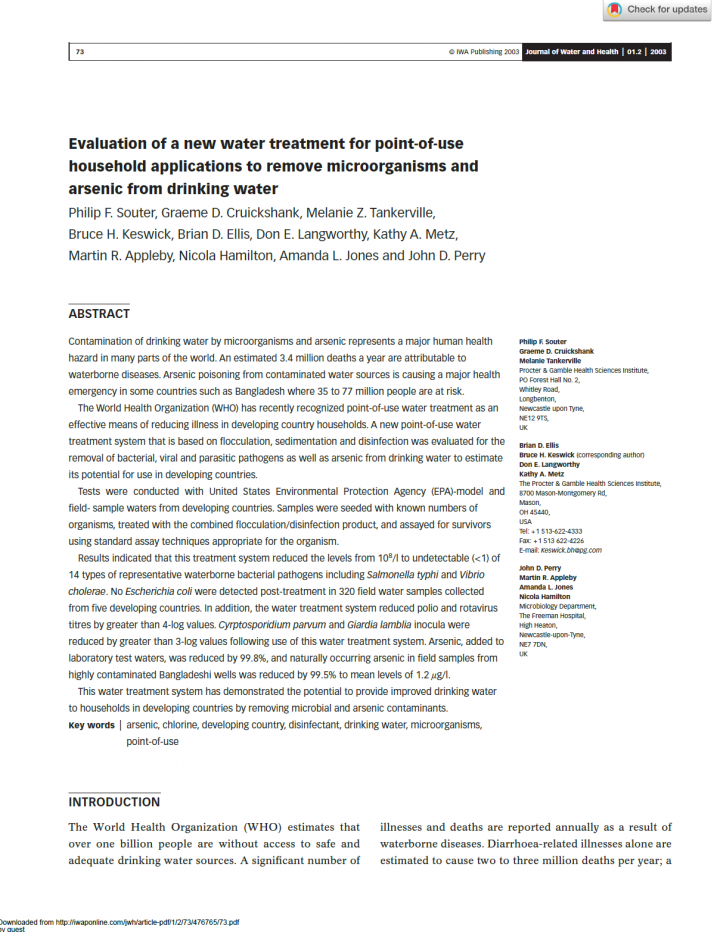Evaluation of a new water treatment for point-of-use household applications to remove microorganisms and arsenic from drinking water
Souter, P. F., Cruickshank, G. D., Tankerville, M. Z., Keswick, B. H., Ellis, B. D., Langworthy, D. E., Metz, K. A., Appleby, M. R., Hamilton, N., Jones, A. L., Perry, J. D. (2003)

Published in: 2003
Pages: 12
Publisher:
IWA - Journal of Water and Health
Author:
Souter, P. F., Cruickshank, G. D., Tankerville, M. Z., Keswick, B. H., Ellis, B. D., Langworthy, D. E., Metz, K. A., Appleby, M. R., Hamilton, N., Jones, A. L., Perry, J. D.
Uploaded by:
SuSanA Admin
Partner profile:
common upload
1272 Views
10 Downloads
Contamination of drinking water by microorganisms and arsenic represents a major human health hazard in many parts of the world. An estimated 3.4 million deaths a year are attributable to waterborne diseases. Arsenic poisoning from contaminated water sources is causing a major health emergency in some countries such as Bangladesh where 35 to 77 million people are at risk.
The World Health Organization (WHO) has recently recognized point-of-use water treatment as an effective means of reducing illness in developing country households. A new point-of-use water treatment system that is based on flocculation, sedimentation and disinfection was evaluated for the removal of bacterial, viral and parasitic pathogens as well as arsenic from drinking water to estimate its potential for use in developing countries. Tests were conducted with United States Environmental Protection Agency (EPA)-model and field- sample waters from developing countries. Samples were seeded with known numbers of organisms, treated with the combined flocculation/disinfection product, and assayed for survivors using standard assay techniques appropriate for the organism.
Results indicated that this treatment system reduced the levels from 108 /l to undetectable (1) of 14 types of representative waterborne bacterial pathogens including Salmonella typhi and Vibrio cholerae. No Escherichia coli were detected post-treatment in 320 field water samples collected from five developing countries. In addition, the water treatment system reduced polio and rotavirus titres by greater than 4-log values. Cyrptosporidium parvum and Giardia lamblia inocula were reduced by greater than 3-log values following use of this water treatment system. Arsenic, added to laboratory test waters, was reduced by 99.8%, and naturally occurring arsenic in field samples from highly contaminated Bangladeshi wells was reduced by 99.5% to mean levels of 1.2 g/l. This water treatment system has demonstrated the potential to provide improved drinking water to households in developing countries by removing microbial and arsenic contaminants.
Content - Summary
Souter, P. F., Cruickshank, G. D., Tankerville, M. Z., Keswick, B. H., Ellis, B. D., Langworthy, D. E., Metz, K. A., Appleby, M. R., Hamilton, N., Jones, A. L., Perry, J. D.
Bibliographic information
Souter, P. F., Cruickshank, G. D., Tankerville, M. Z., Keswick, B. H., Ellis, B. D., Langworthy, D. E., Metz, K. A., Appleby, M. R., Hamilton, N., Jones, A. L., Perry, J. D. (2003). Evaluation of a new water treatment for point-of-use household applications to remove microorganisms and arsenic from drinking water. IWA - Journal of Water and Health
Filter tags
English Politicians and local decision makers Practitioners















